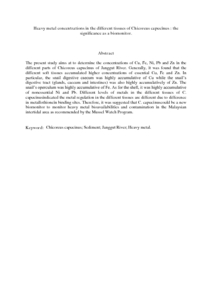Citation
Yap, Chee Kong and Edward Thomas, Franklin Berandah
(2009)
Heavy metal concentrations in the different tissues of Chicoreus capucinus : the significance as a biomonitor.
Malaysian Applied Biology Journal, 38 (2).
pp. 17-21.
ISSN 0126-8643
Abstract
The present study aims at to determine the concentrations of Cu, Fe, Ni, Pb and Zn in the different parts of Chicoreus capucinus of Janggut River. Generally, it was found that the different soft tissues accumulated higher concentrations of essential Cu, Fe and Zn. In particular, the snail digestive caecum was highly accumulative of Cu while the snail’s digestive tract (glands, caecum and intestines) was also highly accumulatively of Zn. The snail’s operculum was highly accumulative of Fe. As for the shell, it was highly accumulative of nonessential Ni and Pb. Different levels of metals in the different tissues of C. capucinusindicated the metal regulation in the different tissues are different due to difference in metallothionein binding sites. Therefore, it was suggested that C. capucinuscould be a new biomonitor to monitor heavy metal bioavailabilities and contamination in the Malaysian intertidal area as recommended by the Mussel Watch Program.
Download File
![[img]](http://psasir.upm.edu.my/14979/1.hassmallThumbnailVersion/Heavy%20metal%20concentrations%20in%20the%20different%20tissues%20of%20Chicoreus%20capucinus.pdf)  Preview |
|
PDF (Abstract)
Heavy metal concentrations in the different tissues of Chicoreus capucinus.pdf
Download (145kB)
| Preview
|
|
Additional Metadata
Actions (login required)
 |
View Item |

